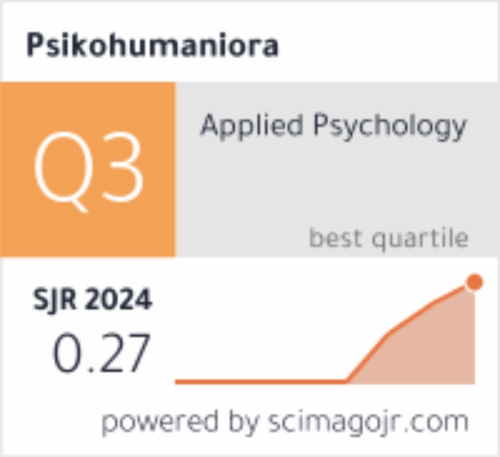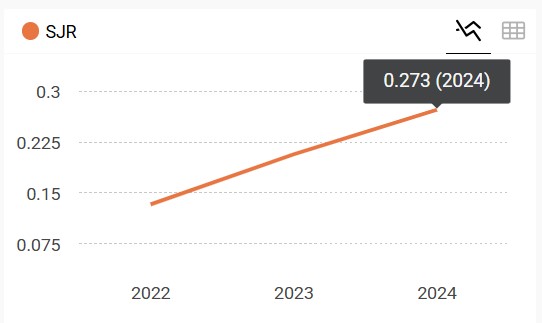Quality of work-life in employees experiencing a job-skill mismatch
DOI:
https://doi.org/10.21580/pjpp.v4i2.2734Keywords:
job involvement, job-skill mismatch, perceived happiness, quality of work-lifeAbstract
Abstract: Quality of Work-life (QWL) in an employee is an important aspect to which a company needs to pay much attention, moreover if the employee experiences a job-skill mismatch. This study aimed to test the effect of job involvement and perceived happiness simultaneously and partially on the quality of work-life in an employee who experiences a job-skill mismatch. The instruments used for collecting data were the QWL scale, job involvement scale, and perceived happiness scale. The subjects of this study were 64 employees. The method of data analysis was the multiple regression analysis. The result of this study showed that job involvement and perceived happiness simultaneously affected QWL (r=0,763; p=0,000). Partially job involvement also had an effect on QWL (r=0.64; p=0,000) and perceived happiness on QWL (r=0,261; p=0,039). Simultaneously, the contribution of job involvement and perceived happiness to the QWL of the employees with a job-skill mismatch was 56.9%. It means that the higher the rate of job involvement and perceived happiness, the higher the quality of work-life an employee with a job-skill mismatch has, and vice versa.
Downloads
References
Azwar, S. (2012). Reliabilitas dan validitas. Yogyakarta: Pustaka Pelajar.
Azwar, S. (2013). Penyusunan skala psikologi. Yogyakarta: Pustaka Pelajar.
Badan Pusat Statistik. (2017). Tingkat Pengangguran Terbuka (TPT) sebesar 5,33 persen. Retrieved from https://www.bps.go.id/pressrelease/2017/05/05/1376/tingkat-pengangguran-terbuka--tpt--sebesar-5-33-persen.html
Bender, K. A., & Roche, K. (2013). Educational mismatch and self-employment. Economics of Education Review, 34, 85–95. https://doi.org/10.1016/j.econedurev.2013.01.010
Cascio, W. F. (1982). Applied psychology in personnel management. Reston: Reston Publishing.
Comyn, P. (2017). The ILO global product on jobs and skills mismatch. International Labour Organization (ILO).
Danna, K., & Griffin, R. W. (1999). Health and well-being in the workplace: A review and synthesis of the literature. Journal of Management, 25(3), 357–384. https://doi.org/10.1177/014920639902500305
Dasgupta, M. (2010). Emotional intelligence emerging as a significant tool for female information technology professionals in managing role conflict and enhancing quality of work-life and happiness. Asian Journal of Management Research.
Easton, S., & Laar, D. Van. (2013). QoWL (Quality of Working Life) - what, how, and why? Psychology Research, 3(10), 596–605. Retrieved from http://www.davidpublishing.com/show.html?14709
Fuadi, M. (2013). Pengaruh kompensasi, lingkungan kerja dan keterlibatan kerja terhadap kualitas kehidupan kerja pegawai pada dinas pendidikan provinsi Aceh. Jurnal Manajemen Pascasarjana Universitas Syiah Kuala, 2(1).
Kaur, A. (2016). Quality of work life. International Journal of Engineering Science and Computing, 6(7), 8305–8311.
Lau, R. S. M., & May, B. E. (1998). A win-win paradigm for quality of work life and business performance. Human Resource Development Quarterly, 9(3), 211–226. https://doi.org/10.1002/hrdq.3920090302
Lodahl, T. M., & Kejnar, M. (1965). The definition and measurement of job involvement. Journal of Applied Psychology, 49(1), 24–33. https://doi.org/10.1037/h0021692
Lyubomirsky, S., & Lepper, H. S. (1999). A measure of subjective happiness: Preliminary reliability and construct validation. Social Indicators Research, 46(2), 137–155. https://doi.org/10.1023/A:1006824100041
Mardiana, C. F. (2017, August). 63% orang Indonesia bekerja tak sesuai jurusan. DetikFinance.
Oshagbemi, T. (1999). Overall job satisfaction: How good are single versus multiple‐item measures? Journal of Managerial Psychology, 14(5), 388–403. https://doi.org/10.1108/02683949910277148
Pettijohn, T. F., & Pettijohn, T. F. (1996). Perceived happiness of college students measured by Maslow’s hierarchy of needs. Psychological Reports, 79(3), 759–762. https://doi.org/10.2466/pr0.1996.79.3.759
Priyatno. (2012). Belajar cepat olah data statistik dengan SPSS. Yogyakarta: CV Andi Offset.
Santoso, S. (2014). Statistik multivariat, edisi revisi, konsep dan aplikasi dengan SPSS. Jakarta: PT. Elex Media Komputindo.
Seligman, M. (2005). Authentic happiness: Using the new positive psychology to your potential for lasting fulfillment. Bandung: PT. Mizan Pustaka.
Warr, P., Cook, J., & Wall, T. (1979). Scales for the measurement of some work attitudes and aspects of psychological well-being. Journal of Occupational Psychology, 52(2), 129–148. https://doi.org/10.1111/j.2044-8325.1979.tb00448.x
Downloads
Published
How to Cite
Issue
Section
License
The copyright of the accepted article shall be assigned to the publisher of the journal. The intended copyright includes the right to publish the article in various forms (including reprints). The journal maintains the publishing rights to published articles.
In line with the license, authors and any users (readers and other researchers) are allowed to share and adapt the material only for non-commercial purposes. In addition, the material must be given appropriate credit, provided with a link to the license, and indicated if changes were made. If authors remix, transform, or build upon the material, authors must distribute their contributions under the same license as the original.



